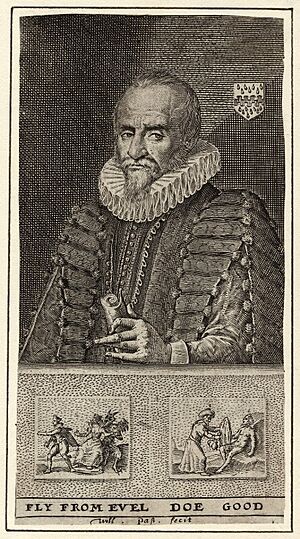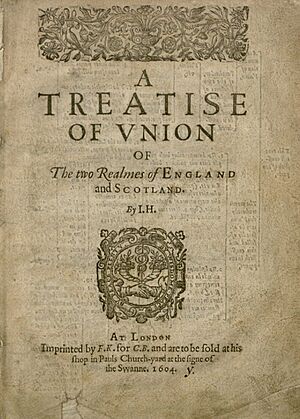John Hayward (historian) facts for kids

Sir John Hayward (born around 1564 – died June 27, 1627) was an English historian, lawyer, and politician. He lived during the time of Queen Elizabeth I and King James I. Hayward was known for writing books about history and for his work in law and government.
Contents
Sir John Hayward's Early Life and Education
Sir John Hayward was born near Felixstowe, in Suffolk, England. He received his early education there. Later, he attended Pembroke College, Cambridge. He earned several degrees from Cambridge, including a Bachelor of Arts (BA) in 1581. He also received a Master of Arts (MA) in 1584 and a Doctor of Laws (LLD) in 1591.
Writing and Royal Attention
In 1599, Hayward published a book called The First Part of the Life and Raigne of King Henrie IIII. This book was about how King Henry IV came to power and how King Richard II was removed from the throne. Hayward dedicated his book to Robert Devereux, 2nd Earl of Essex.
Queen Elizabeth I and her advisors were not happy with the book. They especially disliked its dedication to the Earl of Essex. The Queen asked Francis Bacon to look for parts of the book that seemed to support the Earl of Essex. Hayward was thought to be hinting that the Earl of Essex's military trip to Ireland would fail. This was because his book described similar problems faced by King Richard II in Ireland.
Hayward's Book and Its Impact
On July 11, 1599, Hayward's book was taken and burned. He was then questioned by the Star Chamber, a special court. Queen Elizabeth believed Hayward might be protecting someone else. She wanted to know the truth. Francis Bacon, however, found no evidence of serious wrongdoing in the book. He noted that many sentences in the book were copied from the Roman historian Tacitus.
Hayward's use of Tacitus was new for historians in Britain. He focused on how the personalities and actions of historical figures affected important events. In 1600, the Earl of Essex was found guilty of misusing his power. The next year, he was found guilty of serious offenses and put to death. Hayward's book was used as evidence in both trials. Hayward himself was sent to the Tower of London in July 1600. He stayed there until Queen Elizabeth died.
Life Under King James I
When James I became king in 1603, Hayward tried to gain the new king's favor. He published two new writings. One was called An Answer to the first part of a certaine conference concerning succession. This paper supported the idea of the divine right of kings. This belief stated that a king's power came directly from God. The other writing was A Treatise of Union of England and Scotland.
In 1610, King James appointed Hayward as one of the historians for a new college. This college was founded by the King in Chelsea. In 1613, Hayward published his Lives of the Three Norman Kings of England. He wrote this book because King James's son, Prince Henry, asked him to.
Hayward became Chancellor of Lichfield, Staffordshire, in 1615. He also became an advocate, or legal expert, in 1616. From 1616 to 1627, he worked as a Master in Chancery. This was an important legal role. He was knighted on November 9, 1619, becoming "Sir John Hayward."
Later Works and Legacy
Sir John Hayward passed away in 1627. He was buried in London. After his death, some of his writings were found. One was The Life and Raigne of King Edward VI, which was published in 1630. Another was Certain Yeres of Queen Elizabeth's Raigne. Parts of this were printed in 1636, but the full version came out in 1840.
Hayward's book on Henry IV was reprinted in 1642. His 1603 paper on the Scottish succession was reprinted in 1683. This was done by supporters of the Duke of York. They used it during a debate about who should become king next.
Sir John Hayward was known for being careful and hardworking in finding information. Even though he was imprisoned by Queen Elizabeth, his descriptions of her were still very positive. He also wrote several religious books. While he was in the Tower of London, he published The Sanctuarie of a Troubled Soule (1601). This book was very popular and had many editions. People thought he was a "learned and godly man."


